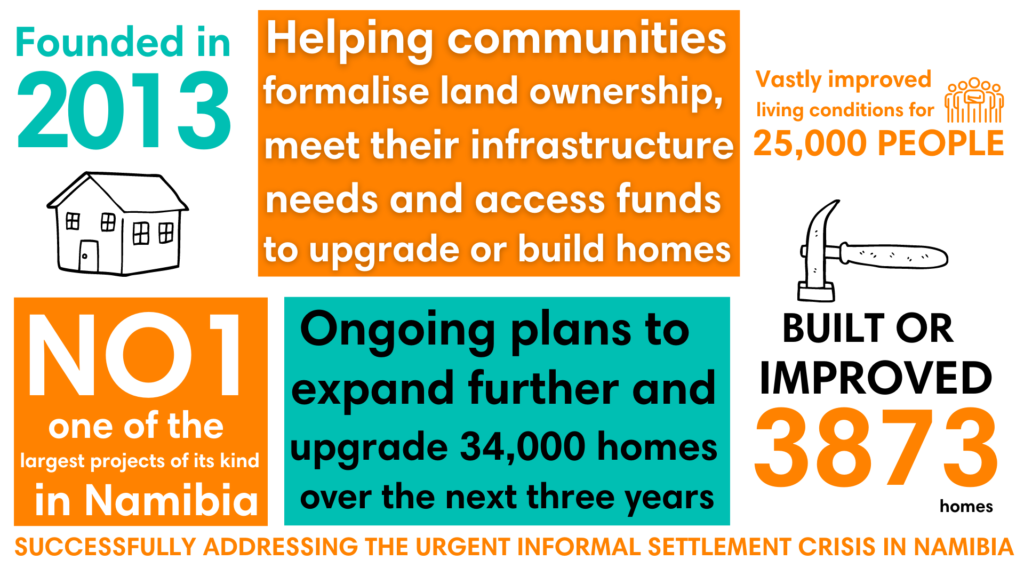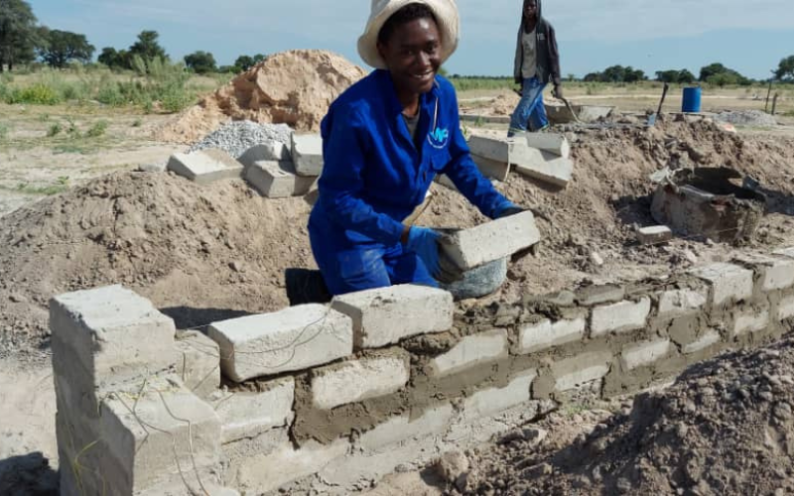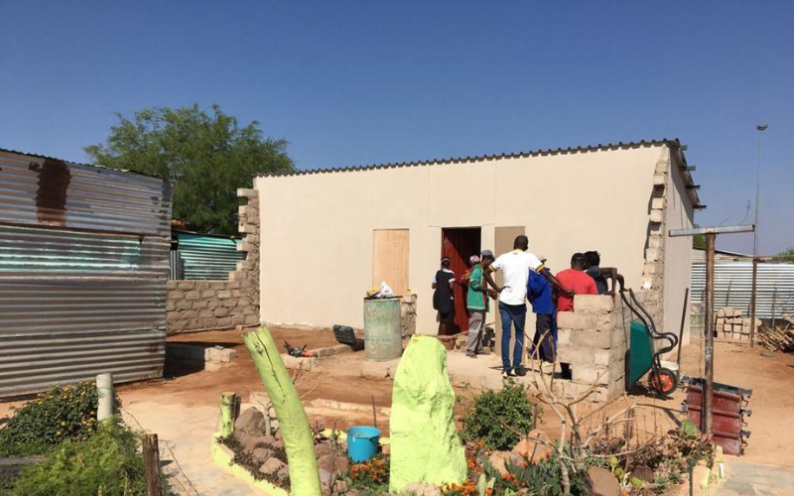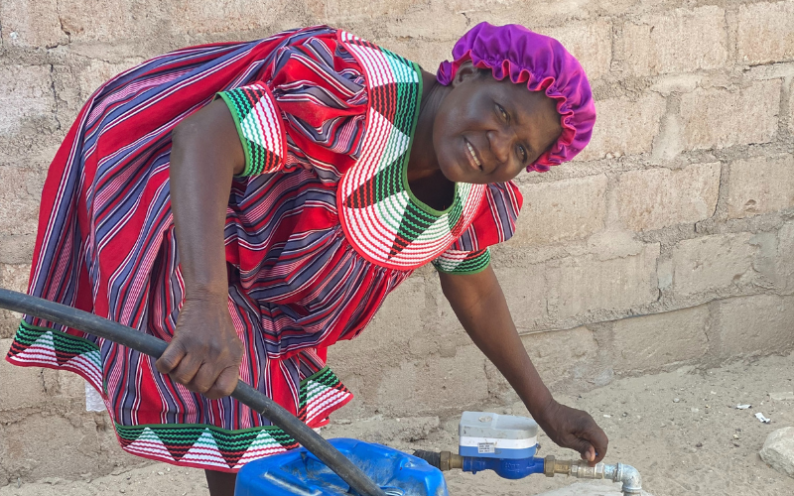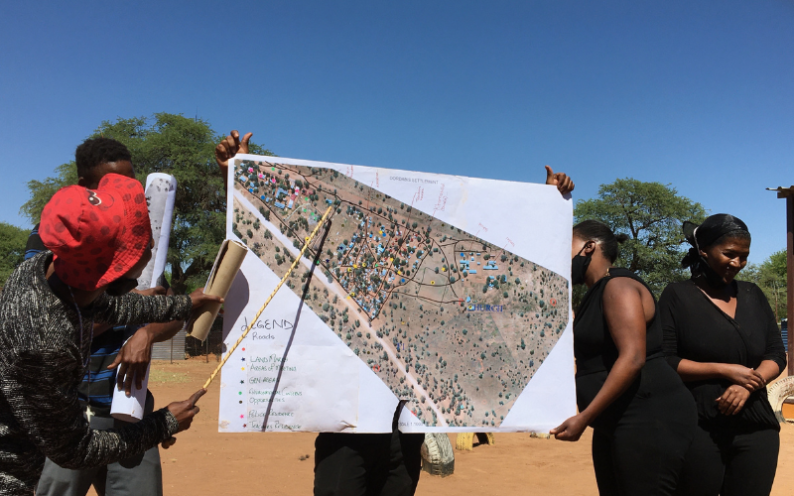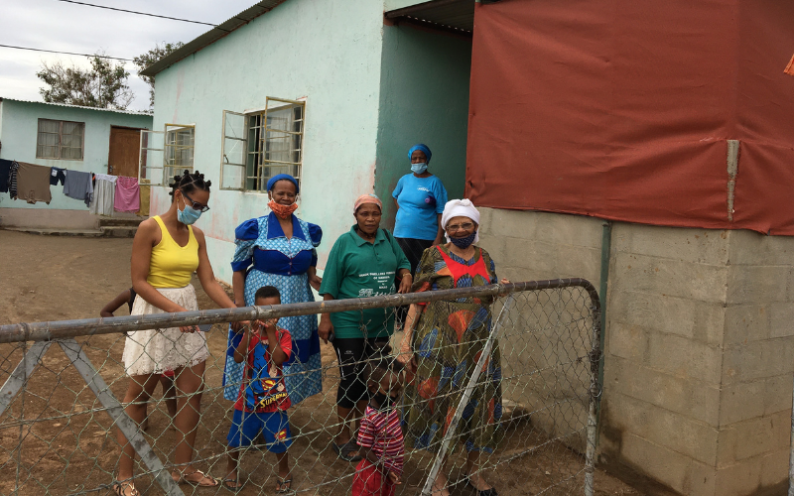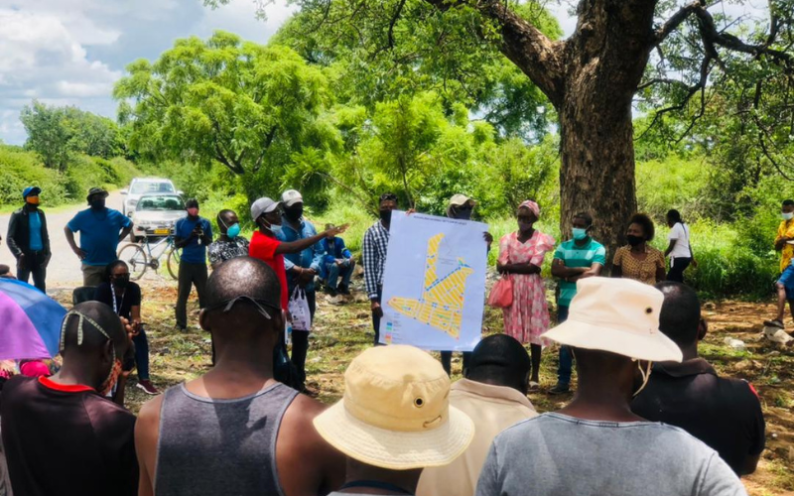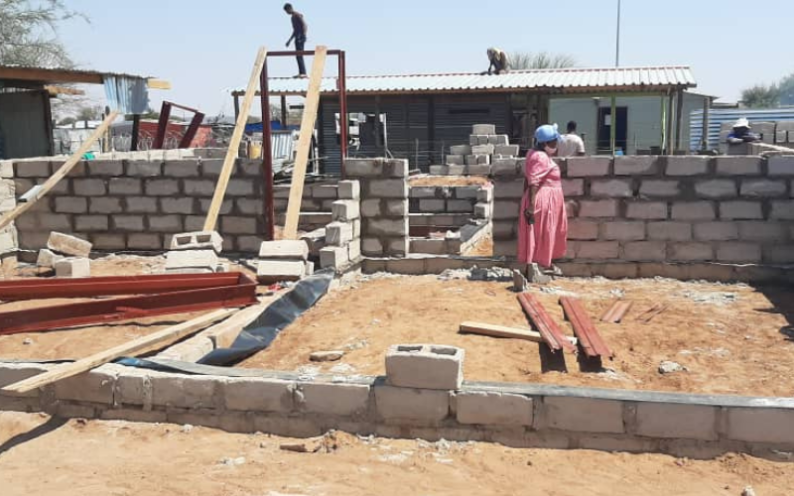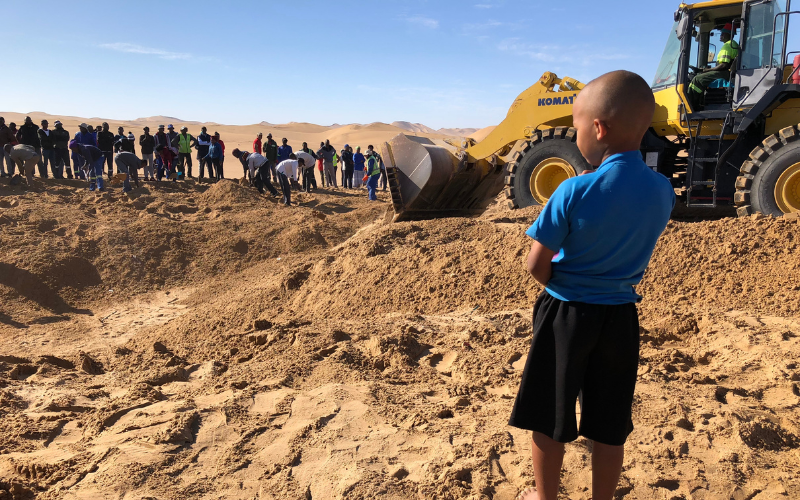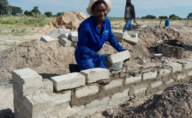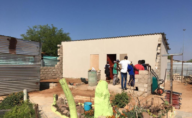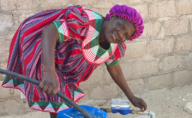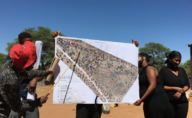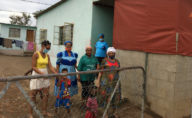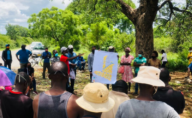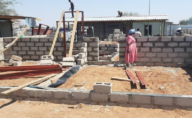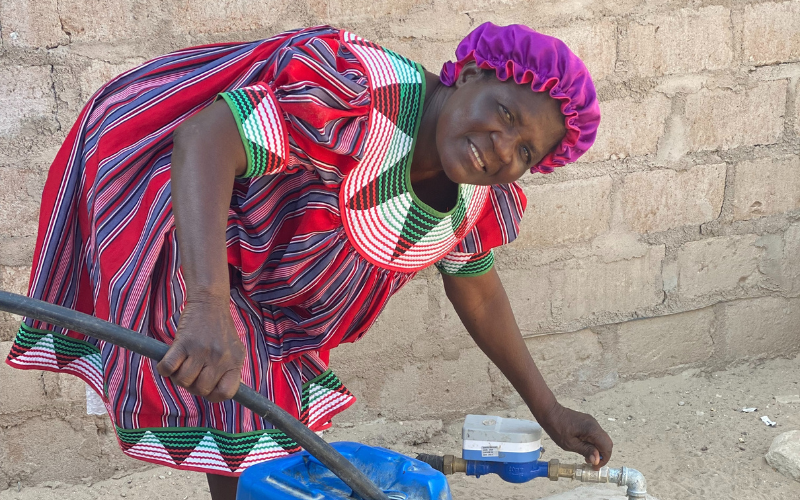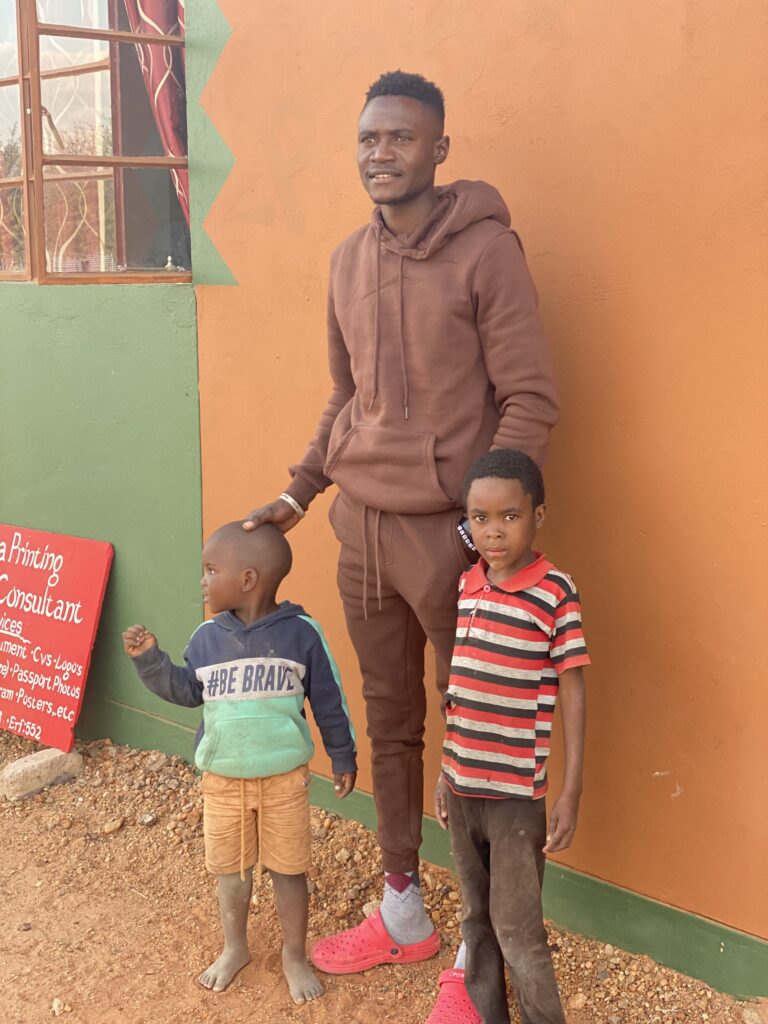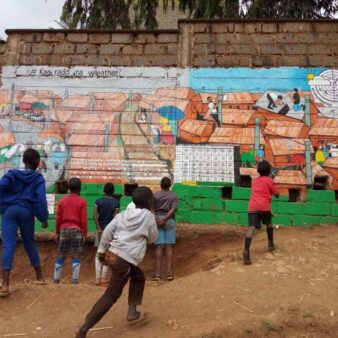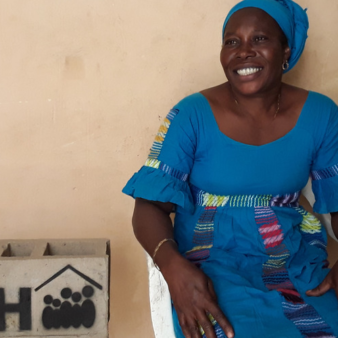Following independence in 1990, Namibia experienced massive migration from rural to urban areas, where a lack of housing development led to the rapid growth of informal settlements across the nation’s major towns and cities.
Today, more than 40% of Namibia’s overall population and the majority of its urban population live in these informal settlements, with little or no access to basic services like electricity, water and toilets. Residents have no legal rights to the land and live under precarious economic conditions.
A total of 89% of Namibians do not qualify for conventional home loans and cannot access commercial housing. As a result, an estimated 12,000 new informal homes are built each year. The task of formalising and upgrading these settlements is huge in scale and too big for the government or municipal authorities to tackle alone.
Community-Driven Housing and Informal Settlement Upgrading is a project that aims to help some of the poorest communities in Namibia by formalising land ownership and helping low-income households access the funds they need to upgrade their existing home or build a new one.
The project is run by the Shack Dwellers Federation of Namibia (SDFN) – a community-based network of housing saving schemes, which is an affiliate of Shack Dwellers International (SDI) – and non-governmental organisation, Namibia Housing Action Group, which supports the activities of the SDFN.
The project began in the city of Gobabis in 2013, after the municipal authority signed a memorandum of understanding with the Namibia Housing Action Group, outlining the upgrading of the city’s four informal settlements through a participatory planning approach involving the community.
Since then, the project has scaled to 10 of Namibia’s 14 regions, 20 urban centres and 31 other informal settlements, making it one of the largest projects of its kind in the country.
The project in practice
The project’s goal is to help members of the SDFN’s community savings groups meet their needs for affordable housing, infrastructure and services – such as sanitation – and land.
Through the Community Land Information Programme (CLIP), a survey of the settlement is carried out by the local authority and community members, who collect data on households and existing infrastructure services. A community-driven settlement plan is drawn up and submitted to the local authority for approval.
A key aspect of the project is the use of the Flexible Land Tenure Act 2012 to provide security of tenure and economic empowerment to people living in informal settlements via two new simpler and cheaper forms of land title: a ‘starter title’ and a ‘land hold title’. Each title is held by the individual, but they are also forms of communal ownership.
Before the establishment of either title, informal land must be divided or combined with other plots to create a portion of land of standard size known as a ‘blockerf’. Each blockerf contains multiple plots of individual households and a communal area. A starter title gives the holder rights over the dwelling at a specified location within a blockerf, while the land hold title gives the holder rights to their plot in the blockerf and the right to use any common property – however, the land must remain communally owned. Land hold titles can also be used as security for credit.
To secure the land, residents must be part of a savings group. This is in part because the land tenure is transferable and this requirement helps mitigate the risk of it being sold to the private market. When someone gets land hold title status, they will become part of the Land Hold Title Association – a community association that entitles them to certain subsidies and financial support. This also allows them to register at the Deeds Registration Office, and to register a bond. The Act allows homeowners to build and upgrade their homes incrementally.
The SDFN’s community development fund, the Twahangana Fund, provides micro loansdevelopment funds to the members of SDFN savings groups for land acquisition, servicing of land, and house upgrading and construction. The fund receives contributions from government (42%), the private sector (17%), external funders (6%), and savings group members (35%). Loans are managed by the savings groups, which also identify loan recipients and obtain supplier and builder quotations.
As of May 2022, the project has built 3,873 homes with water and sanitation services, directly benefitting 25,000 people, and improved services for 2,310 households (which have not yet built their homes) in three informal settlements. Communities are trained to complete their own upgrades and install their own services by technical experts. So far, training has been given to 210 community members.
Land hold titles have been issued to 1,115 registered plot owners in Freedom Square, an informal settlement in Gobabis, and 14 MOUs have been signed with local authorities across Namibia to enable partnerships with their local community savings groups.
Funding
The total cost of the project is $100,000,000 NAD ($6,353,240 USD) with an annual budget of $40,000,000 NAD ($2,541,296 USD). There are two main funding streams within this project: grant funding and the Twahangana Fund.
Grant funding comes from Misereor, GIZ and other international development partners through SDI. The Namibia Housing Action Group manages these finances to support negotiation and advocacy efforts, as well as SDFN processes, network sustainment, and capacity building.
The Twahangana Fund provides soft loans to build 34m2 houses which cost on average between $40,000 NAD ($2,539 USD) and $50,000 NAD ($3,174 USD), including services. The contribution is paid back in full by the borrower. The savings group selects the loan recipient based on their active involvement in the group’s activities (of which regular savings is the main criteria), their ability to make monthly repayments, the overall cost of the house and the upfront payment of 5% of the house loan as a deposit.
After approval, the loan money is paid directly to the suppliers, based on the quotes collected by the group. Each savings group appoints a team to manage the construction. The members also supply their own labour in-kind to reduce building costs.
In Gobabis, the project also managed to raise funds through government programmes, specifically $9,200,000 NAD ($618,000 USD) for servicing land. This was provided by the Ministry of Urban and Rural Development. The ministry also provided $1,000,000 NAD ($67,175 USD) to upgrading projects in Helao Nafidi and $5,000,000 NAD ($335,786 USD) to Karibib and Usab.
Social and environmental impact
This project targets the poorest residents in Namibia, whose monthly incomes fall below $5,000 NAD ($320 USD). Most people in this category do not have formal jobs and do not have access to banking loanssystems.
The land titling aspect of the project gives these residents increased asset security through ownership of their land. Improvements to services and housing upgrades reduce health hazards and safety risks, while the participatory and community-led nature of the project empowers these communities and builds resilience.
This project also encourages greater social cohesion at the community level. Most of the members of the SDFN are women and as such, most of the building teams in the savings groups are made up of women. To help encourage women in the construction sector, the project offers internships for female students on construction sites.
Environmental issues are primarily addressed through risk-sensitive planning, upgrading of dumpsites, promotion of urban agriculture and farming, upcycling, and recycling of materials for community spaces.
Community members help to assess the physical environment, focusing on the environmental resilience of the area, the occurrence of natural disasters, existing land-use zoning, land topography, water features, vegetation, and solid waste management. During planning sessions, communities are encouraged to plant trees and build backyard gardens to improve food security.
Transfer and expansion
The project is ongoing and plans to expand further within Namibia by upgrading 34,000 households in the next three years at an estimated cost of $120 million NAD ($7.6 million USD) per year. The SDFN hopes to construct 1,400 houses for $60 million NAD ($3.8 million USD) in 2022-2023. The hope is that by 2030, more than 700 savings groups will have obtained land and helped members build their own homes.
The Namibia Housing Action Group was instrumental in informing the development of the Flexible Land Tenure Act and is present on the National Housing Advisory Group Committee which advises the housing minister.
The group is lobbying for policy and regulation changes that are more supportive of community-led informal settlement upgrading, in partnership with the relevant authorities and other stakeholders. This advocacy significantly helps with transferability, which relies on partnerships between local authority and community members. The project has also established the National Alliance for Informal Settlement Upgrading to help with in-country scaling.
The Namibia Housing Action Group continues to negotiate with international development agencies and local and national government to contribute to the Twahangana Fund.
This project is successfully responding to the urgent need to address the informal settlement crisis in Namibia. With the revolving Twahangana Fund, the project has developed a sustainable and scalable model that relieves the burden and expense on public authorities, which do not have the capacity to tackle the issue alone. The formation of strong partnerships between local authorities and community savings groups has empowered residents to lead their own upgrading processes and secure their place in the urban landscape.
